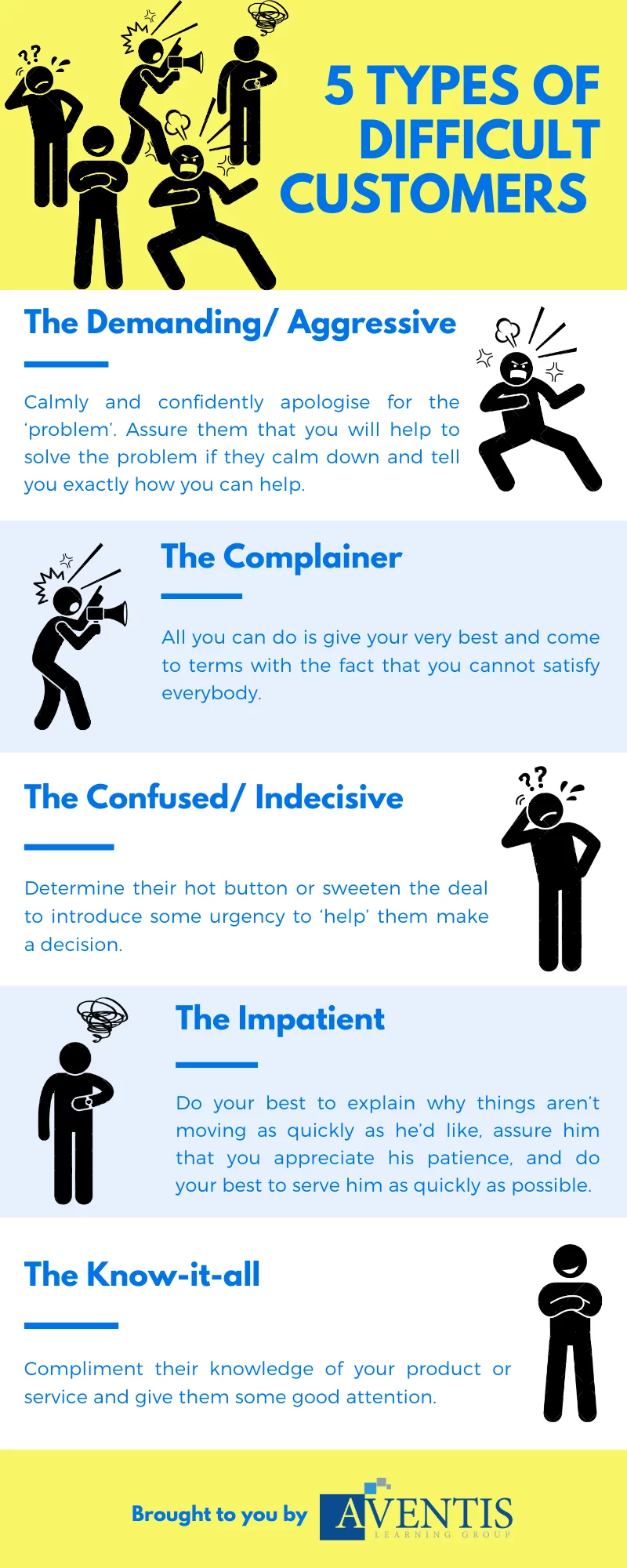
Challenges are part of any business or profession. They may arise from internal factors such as poor organizational structure, terrible work culture, and ineffective management style. These challenges can also extend to the external environment where the people who benefit from your business are becoming one of the contributory factors for the business challenges.
Whether you belong to SMEs, entrepreneurship, or partnerships, you may most likely have encountered one difficult client or two in your entire business journey. The good thing is, with some simple strategies and ways, anyone in the business industry can handle difficult clients effortlessly.
In this blog, we will explore five actionable ways to deal with difficult clients and how they can positively help you and your business build stronger client relationships, create a positive client journey, and enhance your brand image in the public interest.
What are Difficult Clients?
Difficult clients are the type of clients who negatively raise unnecessary difficulties during professional business transactions. They commonly show lousy communication, indecisiveness, hard-pleasing attitude, excessively demanding behavior, overly high expectations, poor comprehension, and other issues that hinder an efficient work collaboration. According to Aventis Learning Group, there are five types of difficult customers.

Oftentimes, some difficult clients may be verbally abusive, either in a written or verbal manner. Some may even speak demeaning words, name-calling, talk personal insults, use foul language, and make rude remarks just to prove a point. On the other hand, there may be difficult clients who are prying and notice every single small detail of work. Being meticulous is understandable but some difficult clients may become a little too nosy, giving unsolicited comments about the service provider’s work, meddling with their business, and even troubling the professional skills or capacity of the service provider which may affect the overall work output and performance.
Progress may also be delayed by difficult clients who prevent giving honest feedback. Their uncertainty may prompt them to say one thing to a service provider during a conversation and then change their mind afterward. This type of behavior might cause miscommunication and keep the business or service provider from completing a job or project.
As a business owner, you should also do your part to always keep a note of every small detail talked throughout— this should not be seen by you alone but also shared with the difficult clients every after a conversation has occurred. This ensures that both parties get the same idea and understanding of what is being pointed out.

There may also be some cases where difficult clients tend to be do-nothing clients where they refuse to either check the work done, allocate some time for collaboration, then leave negative feedback once the work is finalized.
In many instances, they choose to make numerous changes and tweak the original output once it is completed, rather than giving feedback while the job is still ongoing. This type of behavior is not only a waste of resources on the business’s part but also shows disrespect to the business’s time and skills to fulfill the job within the given timeframe.
Uncertainty is not something that should be part of being a professional once you get to work with one business or another. Collaboration is truly important and plans should be made with finality before you enter into an agreement or transaction. It is only reasonable to have minor changes along the process when an unforeseen event may occur.
Any crucial change that distorts the original plan and agreement should not be supported. This not only makes the work easier for both the client and service provider but also makes the process go smoothly rather than being all over the place.

Difficult clients may also request beyond their capacity to pay or afford a service. They may even ask for more favors like discounts, a quicker turnaround time than what has been arranged, more outputs than what is agreed upon, and even room for late payment settlement.
An agreement is made to ensure service quality, ensure that the service covers actual costs, and avoid compromises. Thus, demanding beyond a contract or agreement is unreasonable and should not be fulfilled. This is only just, to give a contract or an agreement credibility and leave no room for misinterpretation.
Any client is entitled to their rights as a client. They are entitled to the service agreed upon in a written contract or verbal agreement between them and a business. Clients also have the right to share their insights, comments, and requests as long as it is feasible and within the cover of the mutual agreement. Anything beyond that is considered to be boundaries crossed— as businesses should always be professional and honest and there should be no personal matter involved.
Upon knowing what difficult clients are, as a business owner, you should know how to recognize a difficult client to be able to approach their needs specifically and that will be addressed further in this blog.
Importance of Dealing with Difficult Clients
A beginner in business may come across this blog since they encountered a difficult client or maybe even stop and wonder, Why waste time dealing with difficult clients? The short answer is, it’s part of the business. The more defined responses are as follows.
The importance of dealing with difficult clients is that it empowers the overall business by retaining clients, builds experience for you, as a business owner, and establishes confidence in customer relationships. Challenges like difficult clients are inevitable. This is why entrepreneurs and business owners should be prepared with their approach to handling one.

By dealing with a difficult client, business owners display these characteristics and behaviors that contribute to their all-in-all brand image:
- Show value to the client’s opinions and empathize with them
Showing value to the client’s opinions and empathizing with them means acknowledging and respecting their viewpoints and feelings. It involves actively listening, understanding their perspective, and demonstrating that their voices matter. By doing so, you build trust and rapport, creating a stronger client relationship and building a more collaborative and positive working environment.
- Lessen the negative impact on the organization
Handling a difficult client lessens the negative impact on the organization with proactive steps to minimize the consequences of certain actions or events that may affect the company as a whole. This can involve risk mitigation, crisis management, or strategic planning to safeguard the company’s reputation, financial stability, and overall being.
- Retain the client’s trust in the company
Building trust in your business is one of the most challenging parts of client relationships— but retaining that trust is as tough. When you effectively deal with difficult clients, this creates a viewpoint of you being trustworthy to address an issue and fix it. When clients trust the company, they are more likely to stay loyal, refer others, and continue doing business, contributing to the business’s success and image.

- Address new problems and issues
Addressing new problems and issues identifies, analyzes, and effectively resolves emerging challenges within an organization or project. A business requires adaptability, problem-solving skills, and a proactive approach to maintain efficiency and progress. Any client appreciates when their problems are acknowledged, addressed, and resolved. This helps them rely and trust on the business better.
- Demonstrate a positive attitude in difficult situations
Besides problems and issues being addressed, how it was handled is also another thing. If a business resolved the conflict unpleasantly, the client satisfaction would still not be fulfilled. Anything you do in business cannot be retracted so it is important to always demonstrate a positive attitude no matter how difficult the situation is. A positive attitude will always be remembered and so will a negative one— thus, choosing the appropriate and professional measures should always be the standard.
As much as it’s important to protect a business’s image, an understanding and patient handling of difficult clients is just as significant. After all, clients have a huge contribution to any business’s success, and their opinions or comments are just as powerful as they could even make or break.
5 Actionable Ways to Deal with Difficult Clients
A difficult client There are a lot of circumstances when dealing with a difficult client but there are also five actionable ways that could be utilized and help you address their issues more effectively.
1. The Art of Patience: Staying Calm in Challenging Situations
Patience is one of the most important keys in dealing with a difficult client— or any difficult situation as such. Patience helps you develop a good outlook in any situation and it is best practiced by means staying calm where you control your emotions in affecting your actions. Columbia Metropolitan Magazine shared that:
Patience lets you persevere and come up with more productive decisions which leads to greater success.
Staying calm is another thing that is best done while practicing patience. Calmness helps us prevent irrational decisions due to pressure and stress that arise during the process of dealing with a difficult client. Difficult challenges cannot be managed well with poor behavior control. Thus, it is truly a skill to have a refined attitude of patience and calm behavior within the business organization.

How to practice patience and staying calm?
- Keep an open mind
To keep an open mind, a business owner should be receptive to individual perspectives, new ideas, and other viewpoints from a client. An open mind requires the willingness to actively listen to a difficult client reflect on your preconceived concepts in hand and be open to changes. By doing so, you do not immediately dismiss any client’s idea or opinion and see them with understanding and interest.
- Do not take things personally
It sure is popular advice in the professional world but it has more value than being just a piece of friendly advice to your workmate or work colleagues. Taking things personally shows that you are not prepared enough to handle a difficult client. It is unavoidable for a difficult client to utter things that seem to be directly pointed at you but keep in mind that their frustration and upbringing with the situation should be seen in a bigger picture.
As a business owner or professional yourself, dealing with a difficult client is much more important than your own emotions because the business established is not about you— it is about the customers or clients who support and patronize your products or services.
However, the moment your client crosses beyond the line, a safety measure should be taken. This might be two different sides of the same coin but with proper balance, a harmonious relationship could be established between a business and a client.
2. Good Communication: Turning Conflict into Cooperation
Transforming disagreements and challenges into opportunities is feasible with a good communication strategy. Communication is essential because it fosters understanding, reduces misunderstandings, and promotes successful interactions in both personal and professional relationships.
Turning Conflict into Cooperation is all about transforming disagreements and challenges into opportunities for working together effectively. It’s the art of resolving disputes, enhancing relationships, and achieving common goals through open communication, negotiation, and problem-solving. Explore the strategies and insights in this blog to harness the power of cooperation and find constructive solutions.

How to turn conflict into cooperation?
- Do reflective listening
Reflective listening is a listening skill that involves giving mindful attention to the idea, concept, or statement of a person, in this case, a client. Doing reflective listening boosts the listener’s, the [business owner’s] comprehension of the other individual [client]. This helps them clarify what needs to be addressed and resolved during the difficult phase.
According to Indeed, two techniques can be utilized for reflective listening. These are:
- Paraphrasing entails paying attention to the speaker and reflecting on what they say in your own words.
- Mirroring, on the other hand, is the word-for-word repetition of the main points of a message.
As what University of New South Wales mentioned on reflective listening,
Listen more than you talk.
Reflective listening works when you listen, determine, ponder, and confirm the message of your client and address it with resolutions in a professional manner.
- Let the client speak
It may sound simple but it is a complex process that some business owners or entrepreneurs may disregard. Hearing what your client has to say is just as important as giving them an answer. Letting the client speak shows that you give respect to their ideas and feedback and are open to discussions about it. Besides that, letting the client speak their minds displays your patient attitude which foster better client relationship.
3. Setting Boundaries: Protecting Professional Relationships
Setting boundaries at a professional level is crucial as it maintains a healthy work-life balance and fosters mutual respect. Clear boundaries enhance productivity, protect well-being, and ensure professionalism in one’s work, ultimately contributing to a more positive and productive work environment.

How to set boundaries in professional relationships?
- Discuss the precise commitment and expectation
Verbal and written agreements or even contracts should be enough to let both parties know the limitations of the commitment. This not only stands as a credible resource of information but also a clear and precise obligation of each other, both the business and the client.
- Reflect on your work ethic and values
Reflecting on your work ethic and values is essential for maintaining alignment between your principles and actions. It allows you to stay self-aware, and make ethical decisions that are just and fair. By regularly assessing your work ethic and values, you can ensure your professional life is built with integrity.
4. Problem-Solving Techniques: Resolving Issues with a Difficult Client
Any client, not just the difficult ones may experience an issue or two within an entire phase of a transaction. This may arise from a problem with the staff assigned, an expectation not met, poor quality service, and a lot more. It also happens easily when there is a lack of clarity in communication, there are new processes and misplaced expectations.

How to resolve issues with difficult clients?
- Document the circumstances
It is important to keep any complaints, issues, problems, or errors identified. This serves as a record of what needs to be fixed or tweaked, and a proof that something is not right. Documentation preserves knowledge and details that could be used for fact-checking and confirmation.
- Identify the main issue
With the help of the records and documentation, it is also much easier to identify the main issue since you have a firm view of what entirely happened. Identifying the main issue is one of the most important processes in problem solving as it cannot be approached without precisely pointing out the issue.
5. Discussion of Solutions: Providing Solutions to Difficult Clients
To sum up, the five actionable ways, of providing a solution is the awaited part. This is where all the first four ways that have been dissected are being put to good use. Providing solutions is tricky for difficult clients, especially if the final result does not fulfill their expectations. There are no absolute solutions for all problem as it varies from one client to another. However, providing solutions is the only way a business project or transaction can be completed fully with every preference and correction considered.

How to provide solutions to difficult clients?
- Evaluate the problem
Upon identifying the main issues, it is also vital to evaluate them. Before you can finally fix the problem, an evaluation of the situation is needed. It enables the business to think through a problem’s solution and ensure that the resolution will satisfy the originally designed requirements, yield the right answer, and be appropriate for the situation.
- Come up with an efficient resolution
To confirm that a resolution has been efficiently achieved when it is feasible and completed. After the evaluation process, providing a solution is the final step. This is where all the first four ways come together to produce a promising outcome. An efficient resolution should be able to address the bigger issues and even the tiny ones and ensure that nothing is compromised.

Dealing with difficult clients is truly strenuous and involves a lot of effort to be done. The good thing is, with these five actionable ways, any business can handle a difficult client interaction. Always keep in mind that one approach does not fit all.
Once you have identified the characteristics of a difficult client, approach each interaction differently and adjust your communication style accordingly. Consider adopting a different perspective and viewing each encounter as a chance to establish rapport. In whatever circumstance, maintain composure and professionalism. If you play your cards well, you should be able to avoid client churn and instead have a returning customer.
To ease your business, outsourcing is a reliable strategy to consider. By outsourcing, you can not only lessen relatively high costs but also get the opportunity to work with experienced and skilled professionals in the industry. Prime Outsourcing offers a wide pool of outsourcing services to help businesses be it a start-up or established ones, be more productive and efficient service providers.





